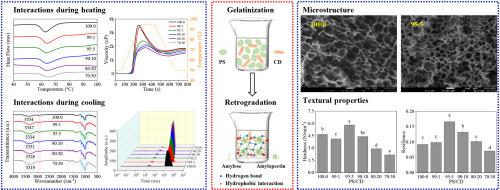凝乳素调节马铃薯淀粉糊化和凝胶化:水凝胶食品中相互作用、结构增强和质地改善的机制
IF 11
1区 农林科学
Q1 CHEMISTRY, APPLIED
引用次数: 0
摘要
为了解决低浓度马铃薯淀粉(PS)凝胶加工性差和质地不良的问题,我们假设凝乳素(CD)通过竞争性吸水和分子间相互作用调节了这些限制。本研究使用快速粘度分析(RVA)、差示扫描量热法(DSC)、流变学、小角度x射线散射(SAXS)、低场核磁共振(fl - nmr)和结构分析系统地研究了PS/CD混合体系(5 wt%,比例100:0-70:30)。在加热过程中,CD与PS争水,通过限制非晶态水化和促进晶域解体,延迟糊化(Tc↑4.02±0.63℃),降低粘度(95:5时粘度峰值↓31.3%),降低糊化焓(ΔH↓37.8%)。CD同时减弱了剪切变薄行为(约38%),提高了可加工性。在冷却过程中,CD通过疏水结合和氢键加速了网络的形成,增加了凝胶弹性(在25°C和70:30时G ^ 336%)和分形维数(D ^ 4.3%)。最佳的CD添加量(95:5)产生了更致密的双网络结构,孔隙缩小50%,纹理性能优越(硬度21%,咀嚼度83%)。然而,过量的CD (> 20%)由于增加了分子间距而抑制了网络的完整性。这些发现证明了CD在抑制糊化和加速糊化方面的双重作用,为定制高质量ps基食品的可加工性和质地提供了实用的策略。本文章由计算机程序翻译,如有差异,请以英文原文为准。

Curdlan modulates potato starch gelatinization and gelation: Mechanisms of interaction, structural enhancement, and texture improvement in hydrogel foods
To address the poor processability and undesirable texture of low-concentration potato starch (PS) gels, we hypothesized that curdlan (CD) modulates these limitations through competitive water absorption and intermolecular interactions. This study systematically investigated PS/CD blend systems (5 wt%, ratios 100:0–70:30) using rapid visco analysis (RVA), differential scanning calorimetry (DSC), rheology, small-angle X-ray scattering (SAXS), low-field nuclear magnetic resonance (LF-NMR), and texture profiling. During heating, CD competed with PS for water, delaying gelatinization (Tc ↑4.02 ± 0.63 °C), reducing viscosity (peak viscosity ↓31.3 % at 95:5), and lowering gelatinization enthalpy (ΔH ↓37.8 %) by restricting amorphous hydration and facilitating crystalline domain disintegration. CD simultaneously attenuated shear-thinning behavior (n ↑38 %), enhancing processability. During cooling, CD accelerated network formation via hydrophobic associations and hydrogen bonding, increasing gel elasticity (G′ ↑336 % at 25 °C and 70:30) and fractal dimension (D ↑4.3 %). Optimal CD addition (95:5) yielded a denser dual-network structure with 50 % smaller pores and superior textural properties (hardness ↑21 %, chewiness ↑83 %). However, excessive CD (>20 %) inhibited network integrity due to increased molecular spacing. These findings demonstrate CD's dual role in inhibiting gelatinization yet accelerating gelation, providing a practical strategy to tailor the processability and texture of high-quality PS-based foods.
求助全文
通过发布文献求助,成功后即可免费获取论文全文。
去求助
来源期刊

Food Hydrocolloids
工程技术-食品科技
CiteScore
19.90
自引率
14.00%
发文量
871
审稿时长
37 days
期刊介绍:
Food Hydrocolloids publishes original and innovative research focused on the characterization, functional properties, and applications of hydrocolloid materials used in food products. These hydrocolloids, defined as polysaccharides and proteins of commercial importance, are added to control aspects such as texture, stability, rheology, and sensory properties. The research's primary emphasis should be on the hydrocolloids themselves, with thorough descriptions of their source, nature, and physicochemical characteristics. Manuscripts are expected to clearly outline specific aims and objectives, include a fundamental discussion of research findings at the molecular level, and address the significance of the results. Studies on hydrocolloids in complex formulations should concentrate on their overall properties and mechanisms of action, while simple formulation development studies may not be considered for publication.
The main areas of interest are:
-Chemical and physicochemical characterisation
Thermal properties including glass transitions and conformational changes-
Rheological properties including viscosity, viscoelastic properties and gelation behaviour-
The influence on organoleptic properties-
Interfacial properties including stabilisation of dispersions, emulsions and foams-
Film forming properties with application to edible films and active packaging-
Encapsulation and controlled release of active compounds-
The influence on health including their role as dietary fibre-
Manipulation of hydrocolloid structure and functionality through chemical, biochemical and physical processes-
New hydrocolloids and hydrocolloid sources of commercial potential.
The Journal also publishes Review articles that provide an overview of the latest developments in topics of specific interest to researchers in this field of activity.
 求助内容:
求助内容: 应助结果提醒方式:
应助结果提醒方式:


